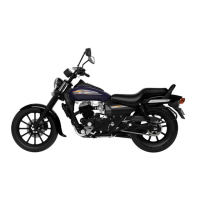
Do you have a question about the Bajaj Avenger 150 Street and is the answer not in the manual?
| Engine Displacement | 149 cc |
|---|---|
| Max Torque | 12.5 Nm @ 6500 rpm |
| Transmission | 5-speed |
| Fuel System | Carburetor |
| Front Brake | Disc |
| Rear Brake | Drum |
| Fuel Tank Capacity | 14 liters |
| Kerb Weight | 148 kg |
| Starting | Electric Start |
| Front Suspension | Telescopic |
| Rear Suspension | Twin Shock Absorbers |
| Front Tyre | 90/90 - 17 |
| Rear Tyre | 130/90 - 15 |
| Seat Height | 725 mm |
| Ground Clearance | 169 mm |
| Wheelbase | 1480 mm |
| Engine Type | Single Cylinder, Air Cooled |
| Ignition | Digital |
| Clutch | Wet, Multi Plate Type |
| Frame Type | Double Cradle |
Details about engine type, bore, stroke, displacement, etc.
Details about front and rear brakes.
Capacity of the fuel tank.
Physical dimensions of the vehicle.
Front and rear tyre sizes and pressures.
Kerb and gross vehicle weight.
Voltage and capacity of the electrical system.
Details on headlamp, pilot lamp, and various indicators.
Battery voltage and capacity.
Horn specification.
Location and format of the frame number.
Location and format of the engine number.
Visual identification of major motorcycle parts.
Explanation of ignition lock positions and key removal.
Instructions for locking and unlocking the steering.
Information on the common key for multiple locks.
Explanation of fuel tap lever positions (ON, RES, OFF).
Instructions for opening and locking the fuel tank cap.
Explanation of speedometer functionality when ignition is ON.
Description of odometer and trip meter functions.
Explanation of various indicator lights on the speedometer.
Description of the odometer display and its rollover.
Description of the trip meter and its rollover.
Steps to reset the trip meter using the knob.
Description of dipper, turn signal, and horn switches.
Explanation of the pass switch for signalling.
Description of head light switch and starter button.
Function and importance of the engine kill switch.
Step-by-step guide to removing the right side cover.
Step-by-step guide to fitting the right side cover.
Location of the battery inside the side cover and its features.
Location of the tool kit and first aid kit compartments.
List of crucial items to check before riding the motorcycle.
Procedure for starting the engine, including choke usage.
Advice on starting warm engines and starter button use.
Steps for starting the motorcycle from a standstill.
Guidance on shifting gears smoothly and safely.
Instructions on effective braking and cornering.
Guidelines for stopping and parking the motorcycle safely.
Speed limits and advice for the first 2000 kms.
Tips for improving fuel efficiency and efficient riding.
Method for calculating fuel efficiency.
Key maintenance checks for optimal bike performance.
Essential advice for safe riding practices and precautions.
Specific care instructions for riding in rainy conditions.
Specification of the recommended engine oil grade.
Procedure for checking the engine oil level.
Engine oil capacity for servicing and overhaul.
Details about the battery type, location, and features.
Tips for maintaining battery health and longevity.
Correct tyre pressure for front and rear wheels.
Note on ensuring tyre fitment complies with regulations.
Procedure for checking and maintaining front brake fluid.
Instructions for adjusting headlight beam vertically and horizontally.
Steps for removing, cleaning, and adjusting spark plugs.
Information on checking and adjusting drive chain slackness.
Procedure for cleaning the drive chain.
Method for lubricating O-ring chains using spray.
Frequency for vehicle washing and engine oil/filter services.
Frequency for cleaning oil strainer and centrifugal filter.
Maintenance for starter clutch and spark plugs.
Service frequency for the air cleaner element.
Maintenance of air filter, fuel cock, and fuel pipe.
Maintenance of carburettor, valve tappets, and engine breather tube.
Maintenance of drive chain, lubrication, and silencer drain hole cleaning.
Maintenance of brake cams, pads, fluid, and disk brake assembly.
Maintenance of cables, wiring harness, and ignition switch barrel.
Cleaning handlebar controls and checking steering play.
Maintenance of bearings, stand pins, and fastener tightness.
General lubrication points and idle speed adjustment.
Maintenance of front fork dust seal and rubber bellow.
Procedures for maintaining the vehicle during long periods of non-use.
Guidelines for storing the battery separately.
Steps to take before using the vehicle after storage.
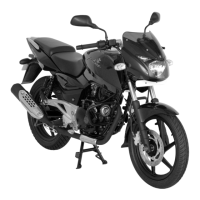
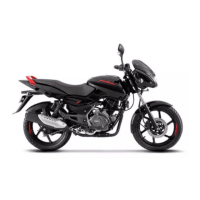
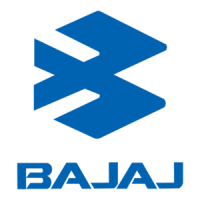
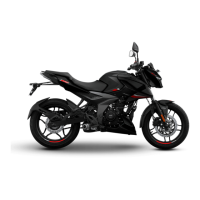
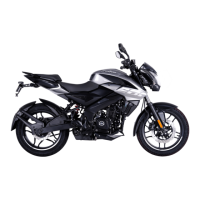
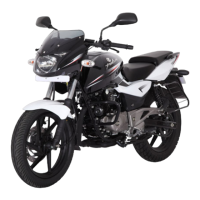
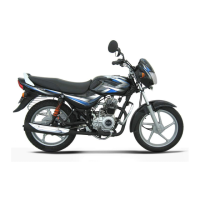
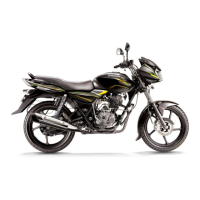

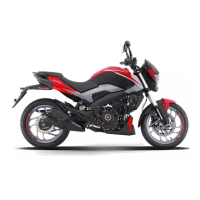
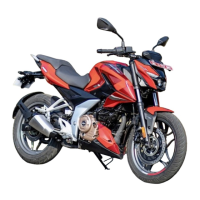
